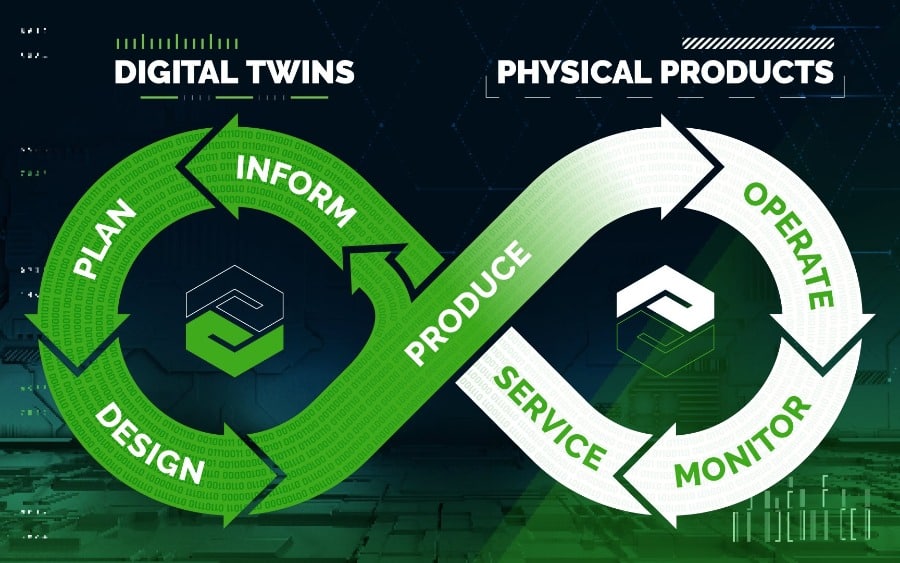If you learned that your competitors had adopted a new tool that improved operational efficiency, time to market, product quality, and the ability to meet customer expectations, you’d want some of that too. Yet a recent survey conducted by CorporateLeaders shows that only 23 percent of respondents have completed their digital transformation journey, and 23 percent have no plans for digital transformation at all. That 23 percent are leaving themselves open to becoming irrelevant in their industries as early and middle adopters surge ahead capturing market share. Read on to learn more about the results of this fascinating survey.
According to CorporateLeaders 23% of companies have no plan for future digital transformation.
The Impetus to Digital Transformation
 Many traditional product lines—everything from HVAC systems to toothbrushes—are undergoing a digital transformation. Consumers and businesses alike enjoy the benefits of digital products. Printers that order their own ink cartridges; refrigerators that create a shopping list; and industrial equipment that schedules its own maintenance are just a few of the conveniences that digitization has created.
Many traditional product lines—everything from HVAC systems to toothbrushes—are undergoing a digital transformation. Consumers and businesses alike enjoy the benefits of digital products. Printers that order their own ink cartridges; refrigerators that create a shopping list; and industrial equipment that schedules its own maintenance are just a few of the conveniences that digitization has created.
Product Lifecycle Management (PLM) Technology
Closed-loop PLM products from PTC are essential components of any company’s journey to digital transformation. Modern PLM tools like PTC Windchill and ThingWorx capture product information at every stage of the product lifecycle.
These tools enable engineers to design better products faster using digital twins and AR (augmented reality) to see how customers interact with products without the need for expensive physical prototypes or focus groups. Digital twins in production enable manufacturers to design processes that are lean and efficient while producing consistent quality, and information gathered over the IoT provides insight into how products operate in the wild, giving the design team valuable information about about mean time between failures (MTBF) and preventive maintenance.
PLM tools help engineers design better products faster by utilizing technology to see how customers interact with products without physical prototypes.
The manufacturers who responded to this survey are well aware of the reasons to adopt PLM and product digitization. Forty percent cited improved operational efficiency as the top benefit, while a close second at 36 percent cited faster time to market as the top benefit. Meeting changing customer expectations came in third at 35 percent. Improving new product introduction and improving product quality made up the rest of the top five at 26 and 25 percent, respectively.
IoT and Digital Transformation
 The ability to obtain data directly from products and equipment using sensors is fundamental to digital transformation. The resulting insight helps improve customer satisfaction, improve time to market and ensure product quality by monitoring product performance throughout its lifecycle.
The ability to obtain data directly from products and equipment using sensors is fundamental to digital transformation. The resulting insight helps improve customer satisfaction, improve time to market and ensure product quality by monitoring product performance throughout its lifecycle.
Connected devices enable companies to create new revenue streams. For example, who would ever expect that consumers would pay a monthly fee to have a company monitor the health of their home heating and cooling systems? Yet they do, and these new services charge anywhere from $20 to $70 per month. Other examples of new revenue streams enabled by digital transformation include on-demand 3D printed repair parts and print on demand hardcover books that are printed and delivered as the customer or bookstore places the order.
Many survey respondents intrinsically understand that the IoT is fundamental to digital transformation, as 47 percent called it extremely or very important. The 13 percent who don’t consider it strategically important at all will find their products increasingly lagging others in the market.
Thirty-eight percent of respondents mentioned lack of internal knowledge and skills as a factor holding them back from the IoT. Adopting an IoT-ready platform with built-in templates and support—like PTC ThingWorx—can help to alleviate this concern by providing a cost-effective proven solution.
How the Cloud Affects Your Digital Transformation Journey
One concern that respondents expressed when discussing digitally transforming their products was data privacy and security in the cloud. One possible solution to these concerns is to choose a dual-deployment solution that can operate on-premise or in the cloud. This phased deployment can enable companies to become familiar with the technology and to deploy to the cloud only the data or processes they are comfortable with, eventually moving to full cloud deployment as their confidence and digital product portfolio grows.
Essential Elements of Digital Transformation
PLM is an essential element of any company’s digital transformation. A few companies reported that they intended to go directly to digitizing their products. This is a risky strategy as it may leave the company without the tools and procedures to benefit from the data generated by their products. Yes, you can improve in-house manufacturing processes without digital PLM, but it is slower and more expensive than using a digital twin that replicates the entire process to help identify and eliminate non-value-added steps or steps where quality may be at risk.
PLM is essential to designing products in the age of digital transformation.
The same holds true for new product design. A company can stick with physical prototypes and focus groups, but that’s a costly, slow and laborious process that may leave them unable to compete with nimbler competitors.
Twenty-four percent of respondents mentioned ROI and lack of a business case as barriers to adoption. This is another example of why it pays to work with a top reseller of industry-leading products, like the combination of 3HTi and PTC. As one of the most successful resellers of PTC Windchill, ThingWorx, and Creo, we have experience helping our customers justify the investment in the necessary technology as well as helping ensure that the implementation goes well.

The Benefits of Digital Transformation Are Clear
A full 47 percent of the survey respondents believe that digital transformation enables them to gain competitive advantage, and 37 percent cite the ability to create new business models. Meeting customer expectations, improving product quality, and enabling agility and responsiveness rounded out the top five.
If you would like to learn more about digital transformation and the role of digital PLM, contact us today.

